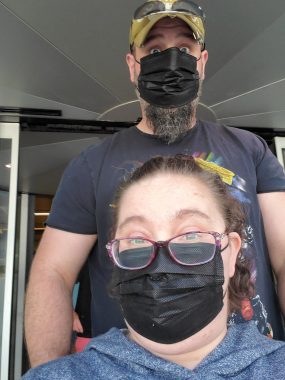How to Manage Medical Burnout With Myasthenia Gravis
Some valuable tips for those feeling overwhelmed by appointments

Sixty-one days, 8.7 weeks, two months, or one-sixth of a year — that’s how much time I spent at medical appointments in 2022.
When I stop to look at the numbers, it’s no wonder I’ve been experiencing medical burnout. This type of burnout is real and brings a unique set of issues.
What is medical burnout?
For me, medical burnout looks like avoiding going to the doctor for anything except a major issue. Last week, for example, I wrote about getting “normal people sick.” I avoided contacting my primary care provider because I just didn’t want to go.
I have a standing appointment every three weeks for my intravenous immunoglobulin infusions. I didn’t want to go. So I pushed it off until I couldn’t.
Now the viral chest bug has morphed into bronchitis that doesn’t want to go away after almost four weeks.
Burnout can also look like self-triaging, where you only bring up the major issues because talking about everything can be too much to handle. I did this for four years. Although I was experiencing ear popping when going up or down small hills and a whooshing sound in my left ear, I never mentioned it until my myasthenia gravis (MG) was better managed. Turns out my ear issues are likely due to Eustachian tube dysfunction.
Triage or sabotage?
When those of us with chronic illnesses try to self-triage, it can sometimes end up being a form of self-sabotage. It’s hard living in a body that fights against itself. It can be just as hard to admit to the seemingly small or inconsequential issues we may be experiencing.
What we need to understand, myself included, is that these small, inconsequential symptoms could be signs of a bigger issue that needs to be addressed.

Columnist Shawna Barnes and her husband, Justin, exit a medical facility after an appointment. (Photo by Shawna Barnes)
What to do about it
It can be utterly exhausting keeping up with the day-to-day requirements of a rare disease like MG. Add acute issues on top of that, and suddenly, our everyday life becomes unbearable and overwhelming.
The first thing to do is acknowledge and accept it. Accept that it’s OK to feel overwhelmed by a cold or getting “normal people sick.” Know that it’s OK to be sick and tired of being sick and tired, and all the appointments that come with it.
Second, show yourself some compassion. You deserve to feel as good as you can. When we push off seeing our providers for acute issues, we put more stress on an already overtaxed body. This can lead to symptom flares or exacerbations. Not good.
The third thing you can do is to give yourself a break with a deadline. Communicate this pause in appointments with your care team and schedule them accordingly. Give yourself a breather. It will give you the time you need to reset your frame of mind to be able to tackle what’s necessary going forward.
Last, let your support network know when you are struggling. Reach out to friends and family and do something fun or frivolous. Recharge your batteries however and whenever you’re able. Lean on those you can and let them support you.
I know it’s hard. I’m right there with you. In 2023, if my regular standing appointments hold true to schedule, I will have 30 appointments by the end of the year. That doesn’t include acute issues or follow-ups with my specialists.
As for me, I’m fighting medical burnout by scheduling a pedicure with my husband. It will be the first time he and I have done that together, and after nearly 12 years together, I am looking forward to another first.
How do you combat medical burnout? Please share in the comments below.
Note: Myasthenia Gravis News is strictly a news and information website about the disease. It does not provide medical advice, diagnosis, or treatment. This content is not intended to be a substitute for professional medical advice, diagnosis, or treatment. Always seek the advice of your physician or other qualified health provider with any questions you may have regarding a medical condition. Never disregard professional medical advice or delay in seeking it because of something you have read on this website. The opinions expressed in this column are not those of Myasthenia Gravis News or its parent company, Bionews, and are intended to spark discussion about issues pertaining to myasthenia gravis.







gerry carter
hello, interesting article. As a veteran you don't have problems from being in combat? Pyrastigmine was given to troops to combat chemical attack and is not good for the body...I am using PEMF and the change in me has been amazing. Less tiredness and Myasthinia in remission I am told. Also using hydroxy gas, reserach George Wiseman. Incredible stuff and finally do yo have a really good water filter! Good luck in your journey x
Shawna Barnes
Hey Gerry. I have lots of problems as a result of being in combat. haha We were not given pyridostigmine bromide as part of our deployment cocktail, and it is a medication that is working well for me now to manage my MG. I am happy to read that you are experiencing minimal symptoms and that your MG is well managed/in remission. Be well!
Annie DeOcampo -Lechtenberg
Excellent article. I’ve had MG for the past 20 years. Rocky road for 12 year of roller coaster crises. I find my MG to be well managed at tis point with hi- weekly IVIG 2 day infusions . That’s at least 24 days each year plus dr appointments, Accupuncture, Chriopractor etc…. Medical burn out is so real along with the costs of fuel, transportation expenses. I’ve been fortunate that I can transport my self but my sweetheart makes himself available when ever possible. Living with MG is challenge. I’m grateful for each day and roll with them.
Shawna Barnes
Hello Annie. Thank you for adding your experiences! I'm glad to read that you seem to have a supportive spouse. Having a great support network certainly helps with medical burnout in my experience. I hope that you continue to have your MG well managed!
Arlene DeLand
The article was very informative. I was diagnosed with - MG back in 2017. I am functioning right now on Pyrostigmine 60mg 3-4 times a day, Mycophenolate, and prednisone. I still am experiencing symptoms of fatigue, left eye drooping, head drooping to the left, etc. My neurologist says the new meds that are coming out are for MG positive for antibodies.
Shawna Barnes
Thanks for commenting Arlene. I am what I would consider "stable" on prednisone, IVIG every 3 weeks, 60mg pyridostigmine bromide (PB) 3-5 times daily, extended release PB, and azathioprine. I continue to see minor improvements on a regular basis so I'm holding out to see just how far this new treatment plan will take me. For me personally, we've finally found something that is working so why mess with it? I am seronegative, so even if the new treatments were available more readily for folks like me, I'm not so sure I'd jump on board. I hope that you are able to continue to work with your care team to find a treatment plan to gets more of your symptoms better controlled.